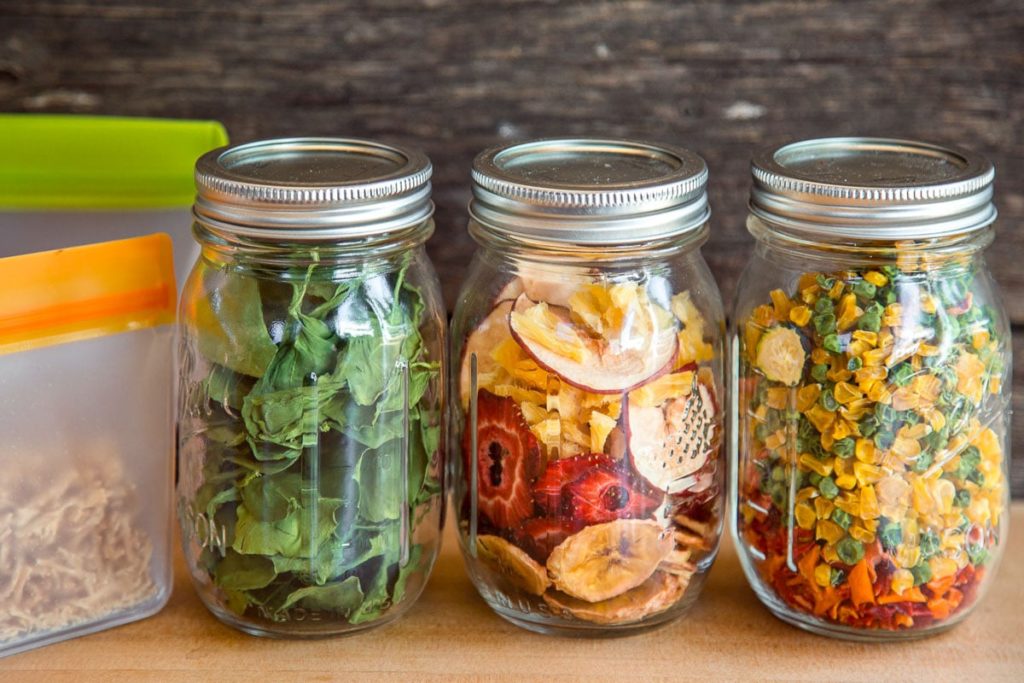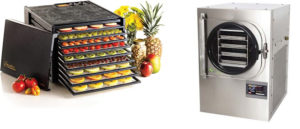I’m sure everyone has given at least a thought to storing food in preparation for an apocalypse. I’m here to offer some explanations and comparisons between two long-term methods: dehydrators and freeze dryers.
What is a Dehydrator/Freeze Dryer?
Dehydrating food has been around for centuries, and freeze drying dates to the early 1900s. As opposed to canning, which loses 60-80% of the nutrients due to the high heat used to preserve the food, freeze-dried or dehydrated food only loses 5%.
A food dehydrator dries out the food so no moisture can develop and thus no bacteria can grow. It’s a small oven that circulates air at very low temperatures for an extended period. This process draws the moisture out of the food. It takes about 8-12 hours, depending on what you’re dehydrating.
A freeze dryer is a bit more scientific: the food is placed into a vacuum-sealed chamber. The temperature is lowered and then raised again until the water in the food changes from liquid to gas (thus evaporating it).
But doesn’t it taste like garbage?
Nope! You can dehydrate or freeze dry simple fruits and veggies as well as soups, casseroles, even pet foods – you simply soak them in water or, in the case of soups, add water. You can even make Grandma’s lasagne and dry that, so you can think of her after you sit down to a nice meal after battling raiders all day.
You do want to consider cross-contamination when drying, so you shouldn’t dry raw meat and veggies together. You’ll also want to think about flavour, as some foods absorb the flavours of others, even when dried. Common Sense Home has even more tips.
You’ll also need to be mindful of what foods don’t dehydrate or freeze well:
Don’t Freeze Dry:
– peanut butter
– pure chocolate
– butter
– honey
– syrup
– jam
– whole fruits and veggies (cut them up first)
Don’t Dehydrate:
– avocados
– olives
– fatty meats
– Nuts (unsoaked)
– peanut Butter
– juices
– sodas
After dehydrating or freezing your food, you can’t just throw it in a Ziploc bag. While there are other options (like canning), the best storage solution is a vacuum sealer, a machine that sucks all the air from a bag while the food is inside, creating an air-tight environment. Because it’s dry, you don’t need to keep it in a freezer, but a cool and dry place is best (like a cold cellar).
If both freeze dryers and dehydrators produce the same product, what’s the difference?
Freeze-dried food lasts longer. Food can be stored for 25-30 years, even without a vacuum sealer. Dehydrated food can last over a year if not vacuum-sealed, but with vacuum sealing, 15-20.
A food dehydrator is far less expensive. You can get some toaster-oven-sized units for under $200, whereas freeze dryers of the same size are over $3000.
Freeze drying is more effective. While dehydrating removes 85-95% of the moisture, freeze-drying removes up to 99%.
Is the price tag on freeze-drying worth the 14% percent and the extra 5-10 years on the shelf? That’s up to you!
Luckily, there are hundreds of Youtubers and Bloggers out there who focus on this stuff, so you can learn from their mistakes before making your own. Make sure to check them out!
Let us know your dehydrating/freeze-drying tips in the comments or on our Facebook group!






Leave a Reply